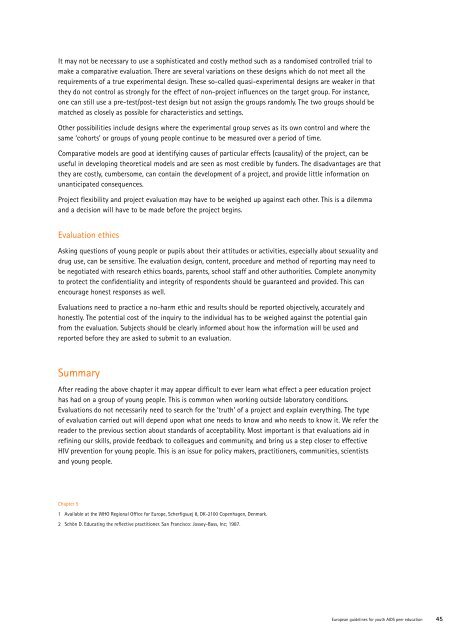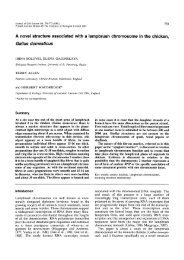European guidelines for youth AIDS peer education - University of ...
European guidelines for youth AIDS peer education - University of ...
European guidelines for youth AIDS peer education - University of ...
- No tags were found...
You also want an ePaper? Increase the reach of your titles
YUMPU automatically turns print PDFs into web optimized ePapers that Google loves.
It may not be necessary to use a sophisticated and costly method such as a randomised controlled trial tomake a comparative evaluation. There are several variations on these designs which do not meet all therequirements <strong>of</strong> a true experimental design. These so-called quasi-experimental designs are weaker in thatthey do not control as strongly <strong>for</strong> the effect <strong>of</strong> non-project influences on the target group. For instance,one can still use a pre-test/post-test design but not assign the groups randomly. The two groups should bematched as closely as possible <strong>for</strong> characteristics and settings.Other possibilities include designs where the experimental group serves as its own control and where thesame ‘cohorts’ or groups <strong>of</strong> young people continue to be measured over a period <strong>of</strong> time.Comparative models are good at identifying causes <strong>of</strong> particular effects (causality) <strong>of</strong> the project, can beuseful in developing theoretical models and are seen as most credible by funders. The disadvantages are thatthey are costly, cumbersome, can contain the development <strong>of</strong> a project, and provide little in<strong>for</strong>mation onunanticipated consequences.Project flexibility and project evaluation may have to be weighed up against each other. This is a dilemmaand a decision will have to be made be<strong>for</strong>e the project begins.Evaluation ethicsAsking questions <strong>of</strong> young people or pupils about their attitudes or activities, especially about sexuality anddrug use, can be sensitive. The evaluation design, content, procedure and method <strong>of</strong> reporting may need tobe negotiated with research ethics boards, parents, school staff and other authorities. Complete anonymityto protect the confidentiality and integrity <strong>of</strong> respondents should be guaranteed and provided. This canencourage honest responses as well.Evaluations need to practice a no-harm ethic and results should be reported objectively, accurately andhonestly. The potential cost <strong>of</strong> the inquiry to the individual has to be weighed against the potential gainfrom the evaluation. Subjects should be clearly in<strong>for</strong>med about how the in<strong>for</strong>mation will be used andreported be<strong>for</strong>e they are asked to submit to an evaluation.SummaryAfter reading the above chapter it may appear difficult to ever learn what effect a <strong>peer</strong> <strong>education</strong> projecthas had on a group <strong>of</strong> young people. This is common when working outside laboratory conditions.Evaluations do not necessarily need to search <strong>for</strong> the ‘truth’ <strong>of</strong> a project and explain everything. The type<strong>of</strong> evaluation carried out will depend upon what one needs to know and who needs to know it. We refer thereader to the previous section about standards <strong>of</strong> acceptability. Most important is that evaluations aid inrefining our skills, provide feedback to colleagues and community, and bring us a step closer to effectiveHIV prevention <strong>for</strong> young people. This is an issue <strong>for</strong> policy makers, practitioners, communities, scientistsand young people.Chapter 51 Available at the WHO Regional Office <strong>for</strong> Europe, Scherfigsuej 8, DK-2100 Copenhagen, Denmark.2 Schön D. Educating the reflective practitioner. San Francisco: Jossey-Bass, Inc; 1987.<strong>European</strong> <strong>guidelines</strong> <strong>for</strong> <strong>youth</strong> <strong>AIDS</strong> <strong>peer</strong> <strong>education</strong> 45
















